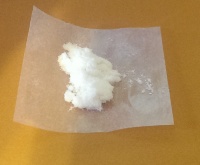Mephedrone: Difference between revisions
(→Links) |
No edit summary |
||
| Line 146: | Line 146: | ||
[[Category:Stimulant]] | [[Category:Stimulant]] | ||
[[Category:Research Chemical]] | |||
Revision as of 15:26, 23 December 2014

General Information
Mephedrone (4-Methylmethcathinone, 4-MMC, and also known by slang terms such as 'meow' and 'M-CAT') is a synthetic stimulant with empathogenic effects. A research chemical first developed as an analogue of MDMA in 1929, it eventually became popular among recreational drug users between 2007 and 2009 as it became available for purchase online. As a result, it was used increasingly in Europe, Australia, and New Zealand, associated with several deaths, and as a result was controlled in some countries.
Because of the similarity in names, it is sometimes confused with Methedrone (4-Methoxymethcathinone, βk-PMMC) or Methylone (βk-MDMA).
Dosage
| Light | 50-100mg |
| Common | 100-200mg |
| Strong | 150-300mg |
| Heavy | 300mg+ |
| Light | 15-25mg |
| Common | 20-80mg |
| Strong | 75-125mg |
| Heavy | 125mg+ |
Duration
Duration may lengthen with higher doses.
| Onset | 15-45 minutes |
| Peak | 15-30 minutes |
| Total | 2-5 hours |
| After-effects | 2-4 hours |
| Onset | 5-15 minutes |
| Peak | 15-30 minutes |
| Total | 1-3 hours |
| After-effects | 2-4 hours |
Effects
Generally described as being more intense of a stimulant than MDMA, providing greater euphoria, but with somewhat less of an empathogenic feel and a shorter length to the 'rush.'
It is often reported as very 'fiendish,' with the tendency to cause users to redose repeatedly throughout the experience.
Postive
- Mental and physical stimulation
- Euphoria, mood lift
- Feelings of empathy, openness
- Increase in sociability, desire to talk with others
- Pleasurable rushing
Neutral
- General change in consciousness (as with most psychoactives)
- Decreased appetite
- Pupil dilation
- Unusual body sensations (facial flushing, chills, goosebumps, body energy)
- Change in body temperature regulation
- Sweating
- Increase in heart rate and blood pressure
Negative
Likelihood of negative side effects increases with higher doses
- Strong desire to redose, craving to recapture initial euphoric rush
- Uncomfortable changes in body temperature (sweating/chills)
- Heart palpitations, sense of racing heart
- Impaired short term memory
- Insomnia
- Tightened jaw muscles, grinding teeth (trismus and bruxia)
- Muscle twitching
- Nystagmus
- Dizziness, light headedness, vertigo
- Vasoconstriction
- When insufflated: pain and swelling in nose and throat, sinusitis
Harm Reduction
- Taking Mephedrone while on SSRIs or MAOIs can cause serotonin syndrome, which can be deadly.
- The drug has not been proven as neurotoxic, however primary indications show that it may well be. As this is the case, care should be taken to space experiences with this drug out - two weeks has been regarded as a good rule of thumb.
- Given the tendency for users to redose, issues such as malnutrition and sleep deprivation may become a problem with extended use. Try to sleep, and see Quick Guide to Stimulant Comedowns for more information on managing a comedown.
Chemistry and Pharmacology
Mephedrone is a releasing agent and reuptake inhibitor of dopamine, serotonin and norepinephrine.
Legal status
For a breakdown of the legal status of Mephedrone click here.